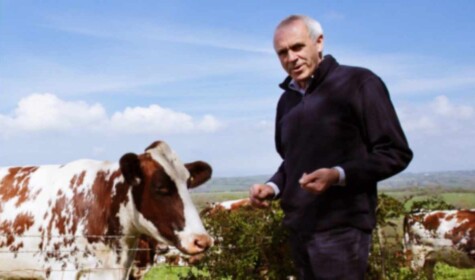The younger generation are positively redefining the way we see ourselves in relation to food and the environment.
I grew up in the late 1960s and so I consider myself a bit of a hippy. That decade marked a fundamental mind-set shift in the way people saw themselves in relation to the world. At the time, it was difficult to pinpoint where these ideas came from; many of them simply seemed to come through intuition.
I mention this because, for the first time since the late 1960s, I feel like another shift in consciousness is occurring among the younger generation, particularly amongst so called ‘millennials’.
There is a new field of scientific study called epigenetics which shows that all living organisms constantly interact with their external environment and that these influences can prompt changes in gene expression which can be passed down through the generations. Plants, for example, have epigenetic responses to the environment they grow in, as a result of which a plant may have a subtle difference in its genotype from its parents. Even more interestingly, certain epigenetic traits can stay dormant for several generations, only to find full expression at a later time.
So I suspect that the changing shift in consciousness towards food production and sustainability may actually be partly epigenetic. Perhaps the radical energy of the 1960s is now finding expression among millennials, albeit in a slightly different way.
For these reasons, as an organic farmer of almost 45 years, I have never been more optimistic about the future of farming. However, I am growing increasingly concerned about the large number of people turning to diets that may not necessarily be either healthy or sustainable.
If we are to move to a genuinely sustainable food system, then I think we all need to become much better informed about the sustainability or otherwise of different food systems. Only then we will be better placed to challenge the huge amounts of misinformation on so-called sustainable diets which are encouraging people to avoid all meats and animal products, despite the reality that in many (if not most climates and regions) it is difficult to farm in a truly sustainable way without livestock.
What is the problem with food and farming?
It has become a cliché but it’s true: supermarket food is not cheap and comes at a heavy price. The industrial application of nitrogen fertiliser has contaminated our water systems and atmosphere with dangerous nitrates; the subsidised production of fructose corn syrup has driven an increase in obesity and diabetes; and the excessive use of antibiotics in animals has caused a resistance to these drugs amongst humans.
The real problem is that none of the costs of all this damage is charged to the people who use it and, on the other hand, the positive effects of sustainable farming are not supported.
The current policy framework supports a dishonest economic food pricing system, as a result of which, the best business case is for farmers to grow using industrial methods and for retailers to buy the commodity products from industrial farms, process the hell out of them, package them so the consumer knows nothing about their backstory and then make a profit by turning that around.
So we need new incentives and disincentives, which ensure that the polluter pays and those who farm in a truly sustainable way are better rewarded for the benefits they deliver.
But what are the most sustainable farming methods?
There is no doubt that agriculture and farming is one of the most significant contributor towards climate change. Cutting back on the biggest pollutant (man-made fossil fuels) is very important but to actually reverse climate change – take CO2 out of the atmosphere – then we need to change the way we farm, particularly in relation to the way we look after the soil.
This is because organic matter in the soil is a store of carbon, thereby mitigating harmful emissions in the atmosphere. Britain’s soils store around 10 billion tonnes of carbon, which is more than total annual global emissions of carbon dioxide. Moreover, high levels of organic matter are also the basis for soil fertility, releasing nutrients for healthy plant growth and ultimately food. In other words, the amount of organic matter present in the soil is essential, both for combating climate change and ultimately improving our health.
 The problem is that industrial farming methods have depleted organic matter in the soils. In the East of England, around 84% of the land’s carbon rich soil has been lost and continues to disappear at a rate of 1 to 2cm per year. That represents an enormous amount of CO2 released into the atmosphere.
The problem is that industrial farming methods have depleted organic matter in the soils. In the East of England, around 84% of the land’s carbon rich soil has been lost and continues to disappear at a rate of 1 to 2cm per year. That represents an enormous amount of CO2 released into the atmosphere.
Sustainable food systems are therefore about much more than simply avoiding nasty chemicals and antibiotics, they are about building organic matter in the soil through crop rotation and mixed farming practices.
It is possible for farmers to reduce the emissions from agriculture by re-introducing rotations in the way they use their land – introducing a grass and clover phase that builds soil organic matter, which is then grazed by ruminant animals on rotation, who fertilise the soil further, and results in an ability to grow healthy crops.
According to the International Panel on Climate Change, it is estimated that 89% of all agricultural emissions can be mitigated by improving carbon levels in the soil.
How can you have the most healthy and sustainable diet?
Everyone, at least in principle, wants to eat a healthy and sustainable diet, but we are all very confused about how to do it. If you asked 10 people what the most sustainable and healthy way to eat was then you would probably get 10 different answers. A few might say vegetarian or vegan (the numbers eating a vegan diet has increased by 360% in the last decade) but I think that a large scale switch towards vegetarianism may not necessarily be compatible with sustainability.
In my opinion, many people have been led astray by bad science. The tools used by scientific researchers in the past, and whose published papers have prompted changes in people’s diets, were not based on sound science. It was said that red meat and animal fats should be avoided, both because they are unhealthy and because ruminant animals (cows and sheep) are largely responsible for harmful methane emissions.
But it turns out that neither of those positions are necessarily true.
The study that prompted Governments in Britain and the United States to recommend people to reduce their intake of fats was not based on solid evidence. It is this study that encouraged the food industry to replace fats with added sugars, and we are only now understanding the damage these do to our health.

And the studies that recommended a reduction in red meat consumption on grounds of reducing its environmental impact only look at certain factors in isolation rather than the whole food system. Land-use is often considered as bad in all instances, even though raising livestock is sometimes the only productive land use option available. In roughly two thirds of the UK’s agricultural land area is grass and the only way we can turn that into a good soil that stores carbon and grows healthy crops is to have ruminant animals grazing on a rotation system to fertilise the ground.
These flawed assumptions have had significant consequences for the way people eat. Beef production has halved since the 1980s and the consumption of lamb, arguably the most sustainable grass-fed meat for the land, has plummeted. While new evidence is now showing that animals fats are good for our health and cattle grazed in the right way can actually reduce carbon emissions by creating fertile soils.
Where do we go from here?
My message is simple: a healthy diet should work backwards from the most sustainable way to farm, and that ideally means eating the foods produced by mixed farms using crop rotations which include a fertility building phase, usually of grass and clover grazed by cows and sheep, but also pastured pigs and poultry.
Industrial farming has been an extractive industry. We have dined out on the natural capital of the soil that previous generations have laid down for us. We need to fix that because the environment in which a plant or animal is produced goes a long way to determine its nutrient value when consumed by humans.




